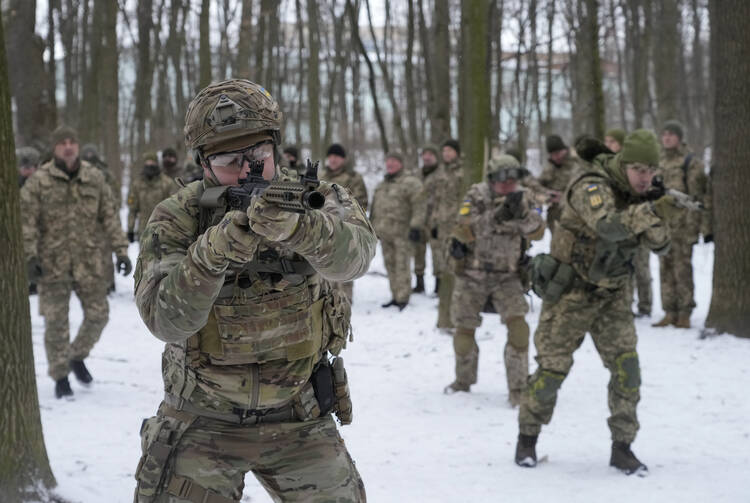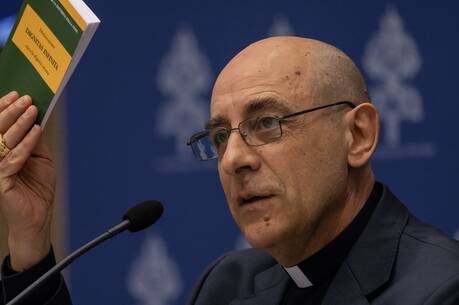For other perspectives on the Ukraine crisis, read “Pope Francis may be our last hope for stopping war in Ukraine” and “Just war theory and Ukraine: Why military action against Russia is justifiable.”
As the crisis in Ukraine accelerates, President Biden and other leaders have acted wisely in continuing diplomatic efforts. However, leaders in the United States and Russia, including Vladimir Putin and Mr. Biden, too often escalate conflict in Eastern Europe with military deployments, at times dehumanizing opponents and rallying their populations for “just wars.” This is the time for creative thinking to avoid a humanitarian and environmental catastrophe.
We can shift to a “just peace” framework. Rather than reacting to perceived threats by trying to one-up an adversary for the sake of “deterrence,” or identifying justifications for war, a just peace approach begins with identifying the root causes of a conflict, as well as the genuine needs of the adversaries.
A just peace approach begins with identifying the root causes of a conflict, as well as the genuine needs of the adversaries.
Some of the root causes of the current crisis are embedded in the complex history of Ukraine, which has been invaded by various empires over the centuries. Like all peoples, they have a right to self-determination and a responsibility to the global common good.
The current crisis was seeded in part by NATO’s expansion after 1997 into 14 additional countries, including former Warsaw Pact countries and three former Soviet states. It was exacerbated by apparent Western interference in the Maidan uprising in 2014 that led to the end of a pro-Russian government. The Minsk Agreement of 2015 was an attempt to interrupt the cycle of violence after the 2014 uprising, Russian annexation of Crimea and armed conflict in eastern Ukraine. However, cease-fire violations continued. Ukraine also refused a dialogue with the leaders of separatist regions in that nation about local elections and the structure of political autonomy (as stipulated in the Minsk Agreement).
At issue for Russia is its quest for more acknowledgment about its security needs, as well as respect in its geopolitical sphere. At issue for NATO and the United States, it seems, is the value of national self-determination and consistency in access to economic resources (including the ability to continue weapons sales). Both sides need to have more trust and expectations of accountability for the actions of the other.
At issue for Russia is its quest for more acknowledgment about its security needs, as well as respect in its geopolitical sphere.
Focusing on root causes, we can explore more effective strategic responses with three components of a just peace approach: cultivating skills to engage conflict constructively; breaking cycles of destructive conflict; and building sustainable peace. Each offers a set of norms that our actions should enhance, or at least not obstruct (see my book A Just Peace Ethic Primer).
For this conflict, a just peace approach from the NATO side might suggest the following strategic approaches as initial actions in a longer process.
1. Avoiding threats of war. This allows alignment of the parties with the United Nations Charter, the Kellogg-Briand Pact (the 1928 international treaty denouncing the use of war) and other promises the parties have made to settle disputes by peaceful means.
2. Avoiding dehumanizing language. This entails refraining from language such as calling Russian leaders “killers,” or using other dehumanizing labels or narratives. It challenges the United States to acknowledge its common humanity with Russians and Ukrainian separatists, allowing for mutually beneficial cooperation.
3. Consistency between means and ends (“reflexivity”). The means used to manage the conflict must be consistent with the ends of partnership, well-being and a sustainable peace. War in Ukraine will kill and maim countless thousands, create millions of refugees, destroy the economy and environment, and could even risk the end of civilization in a nuclear exchange. It is hard to imagine that such means are consistent with a sustainable peace. And there are simply too many viable alternatives to war.
4. Integral disarmament. In the nuclear age, warfare is too risky for our fragile planet. So the United States could take initiatives to diminish, as soon as possible, its military presence in the Eastern European region. This could be done as a quid pro quo agreement to not deploy, or to remove, Russian forces in Ukraine. There is precedent for this, such as the Conventional Armed Forces in Europe Treaty that limits NATO military in Eastern Europe and Russian military in contiguous territories, or the Minsk II agreement of 2015 for a demilitarized Donbas in Ukraine. Honoring current treaties will rebuild trust and remind both parties that they are actually good at making and honoring agreements.
The United States could also suggest replacing the current rush to arm Ukrainians on both sides with an embargo on all weapons deliveries into Ukraine.
5. Acknowledgement of responsibility. The United States could publicly acknowledge the role it played by interfering, via financial and public support to opposition candidates, in the Ukrainian elections in 2014 (just as we would object if Russia supported an anti-U.S. candidate in a Mexican election) and now by supplying weapons to that government. This would give NATO the moral authority to invite Russia to acknowledge responsibility for their harm in supplying weapons and troops to partisans in eastern Ukraine and also interfering in elections. The parties could explore processes for accountability through restorative justice mechanisms. These could be facilitated through a nonpartisan government or civil society-led restorative process, or a U.N. hybrid court.
6. Conflict transformation. This entails NATO taking initiatives to build trust by trying to meet the actual needs of all parties, which would reinvigorate the constructive dialogue and diplomacy needed to prevent war. For example, NATO could announce a moratorium on admitting Ukraine to its membership—with openness to discussing with all stakeholders other options, such as neutrality, in exchange for the removal of Russian troops from Ukraine and significant demobilization of troops on the border.
NATO could announce a moratorium on admitting Ukraine to its membership in exchange for the removal of Russian troops from Ukraine and significant demobilization of troops on the border.
The United States and its allies could also recommend that the Ukrainian government engage in dialogue with the pro-Russian leaders in eastern Ukraine, as included in the Minsk Agreement. This could lead to more clarity in determining the kind of political autonomy for these regions that the Minsk Agreement calls for.
7. Economic justice. This would lead the United States to enable fair, mutually beneficial trade, as well as financial assistance with a focus on those most in need. For example, Russian gas can easily and affordably keep Europeans warm this winter. To interfere with such trade by shipping expensive gas from North America or other far-off countries in order to punish Russia will only add to the hardship of the poorer Europeans and Russians.
8. Nonviolent direct action. If conditions for fruitful negotiations become untenable, this norm invites Ukrainians to lean toward nonviolent resistance to shift power and create better conditions for dialogue. In Ukraine, the Orange Revolution of 2004 was a good example of this, but its results were undermined by corruption and a return to using violence for political gain. Nonetheless, its lessons have stayed with the people to the extent that a poll in December 2021 found that 22 percent of Ukrainians are already prepared for nonviolent civil resistance in case of an invasion, and there is significant potential for this civilian-based defense approach. The United States and others could offer resources to support such training and preparations.
9. Robust civil society. Civil society leaders can use their leverage with political, military and economic leaders, as well as the grassroots, to generate a commitment to just peace practices. This effort could include Ukrainian religious leaders, who may even be able to leverage relationships with Russian Orthodox leaders. And Pope Francis could play a particularly important role, as Pax Christi International suggests.
10. Upholding human dignity. The key to sustainable peace ultimately rests on supporting the dignity of all persons by creating policies that assure that empathy increases, and that the basic human needs for safety, wellness, freedom and respect are well met. Policies that assure these for all parties are the policies of a just peace.
John Reuwer of World Beyond War contributed to the research for this article.








